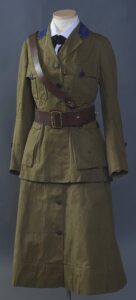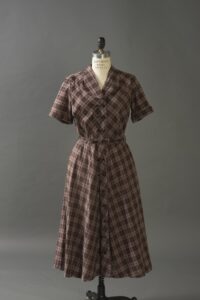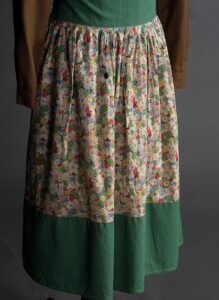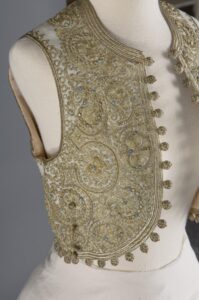Collection Mission Statement
“The Smith College Historic Clothing Collection advances the academic inquiry of women of diverse economic and social backgrounds through the study of their dress from the 19th century to today. This distinctive collection fosters interdisciplinary research, inquiry, and connections through engagement with tangible evidence of women’s lives.”
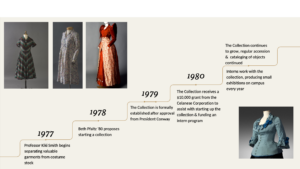
About the Collection
“The Smith College Historic Clothing Collection is an archive of clothing and accessories of women from all social classes in the United States, from 1800 to the present. The Collection includes over 3,000 objects, most of which are donations from Smith College Alumnae and friends of the College.”
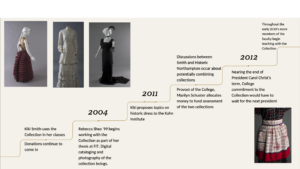
The Smith College Historic Clothing Collection is owned by Smith College and operates as a departmental collection within the Theatre Department. The collection is housed in the basement of Mendenhall. Professor of Theatre, Kiki Smith manages the collection.
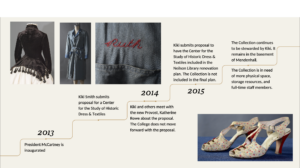
What Makes this Collection Unique? 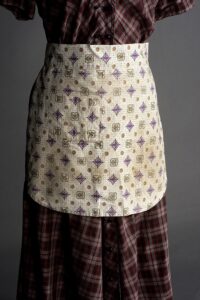
While historic clothing collections do exist at other colleges and universities, the Smith College Historic Clothing Collection sets itself apart from other teaching collections through its content and connection to the institution. This collection has a unique focus on historic women’s clothing and emphasizes the everyday clothing worn by women of all social classes.
Part of what makes this collection different is its nature as a teaching collection. The collection is used in a very hands-on way, giving students the opportunity to engage directly with material culture in a much different way than traditional museum spaces allow. Whereas most museum textile collections only have one example of each specific garment, an effort has been made in the Smith College Historic Clothing Collection to intentionally collect multiples of the same garments. This is valuable for conservation purposes as well to show different wear patterns, mending, and differences in tailoring/alterations. Unlike most traditional museums, the Smith College Historic Clothing Collection holds many objects with visible evidence of use. The wear and tear on many of the garments tangibly displays the relationship between the pieces of clothing and the people who wore them. These qualities are exactly what makes these objects beneficial for study.
The very fact that the majority of the collection is made up of objects donated by Smith Alumnae demonstrates the connection between these historic garments and the College. This collection helps to tell the story of the students who have attended Smith and of their families who helped them to get here.
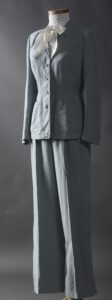
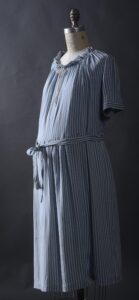
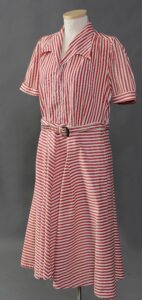
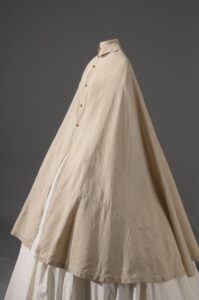
So What’s the Issue?
College interest in the collection has come in waves over the years and has generally resulted in very little movement forward. Kiki Smith has been committed to this collection since its beginnings in the 1970’s. While she has had the assistance of devoted student interns and outside consultants over the years, the collection lacks funding from the college which has prevented the hiring of additional professional collection staff members. It is both unreasonable and unsustainable for Kiki to remain as the sole manager of this collection in addition to her other responsibilities as a faculty member at Smith.
In addition to being understaffed, the theatre department also does not have the ability to allocate enough physical space to safely house the collection. The collection is stored in metal cabinets which are crowded and unsuitable to house the variety of objects in the collection. The collection also doesn’t receive enough funding to consistently purchase a sufficient supply of archival-quality storage materials.
Due to the combination of being understaffed and lacking financial resources, there is not an accurate or complete digital database cataloging the objects in the collection. This makes teaching with and researching the collection more difficult and less accessible.
Because of the status of the Smith College Clothing Collection as a departmental collection within the College, there can be no fundraising efforts specifically for the collection. The collection can receive money if donors choose to specify this collection as the recipient of their money, but cannot ask donors for money. A lack of resources is inhibiting the potential growth of this collection as a teaching resource for the College.
